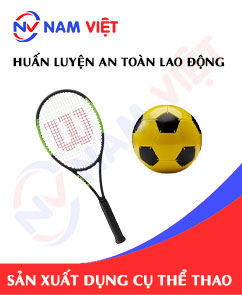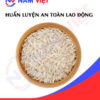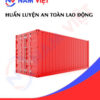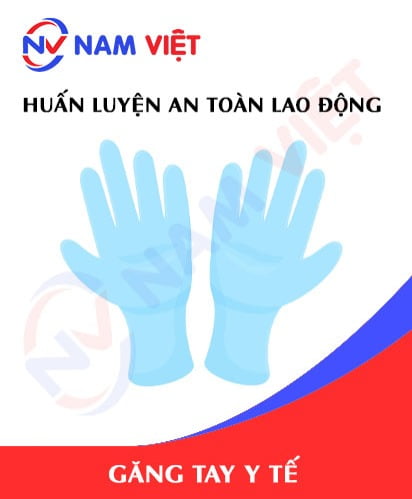Occupational Safety Training For Sports Equipment Manufacturing
99,000 ₫
Note: The above price is calculated for one person, the price may fluctuate depending on the number of trainees participating in the course and the movement of the market. For more accurate pricing support, please refer to the quotation or contact directly with our consultants.
Occupational safety is an important issue in sports equipment manufacturing factories and needs to be addressed promptly to ensure the health and safety of workers, as well as to enhance the reputation of enterprises. The Occupational Safety Training course is one of the effective solutions to raise awareness about preventing occupational accidents for workers participating in sports equipment manufacturing.
Table of Contents
Toggle1. Overview of Sports Equipment
a. What is sports equipment?
Sports equipment refers to tools and devices used for exercising, physical training, and participating in sports activities. Sports equipment is divided into various types, including:
- Exercise equipment: includes machines such as treadmills, exercise bikes, abdominal machines, weight benches, dumbbell racks, etc.
- Outdoor sports equipment: includes equipment used outdoors such as badminton rackets, tennis rackets, basketballs, footballs, volleyballs, paragliders, etc.
- Water sports equipment: includes equipment used in water sports such as surfboards, swimming gear, rowing equipment, etc.
- Training sports equipment: includes equipment used for practice such as golf practice balls, tennis practice balls, yoga balls, muscle training tools, etc.
Sports equipment is designed to help individuals improve health, develop physical fitness and strength, and reduce stress in daily life.

b. Types of machinery used in sports equipment manufacturing
Various types of machinery are used to produce sports equipment, depending on the specific product. Some commonly used machines include:
- Textile machines: used to produce fabrics, such as mesh or canvas.
- Cutting and sewing machines: used to cut and sew fabric pieces into specific products, such as footballs, sports shoes, sports apparel, sports bags, etc.
- Heat press machines: used to print images or logos on products, such as sports shirts, sports hats, etc.
- Wire knitting machines: used to weave elastic cords, straps, ties, etc., used in various sports products.
- Injection molding machines: used to create products from plastic or metal, such as footballs, tennis rackets, etc.
- Wood press machines: used to create wooden products, such as badminton rackets, tennis rackets, etc.
However, many types of sports equipment are produced manually or by other methods without using industrial machinery.

c. Sports equipment manufacturers in Vietnam
Here are some well-known sports equipment brands worldwide:
- Nike: Nike is a leading brand in the manufacturing of sports shoes, apparel, and accessories globally. Founded in 1964 in the United States, Nike is one of the largest and most reputable sports brands worldwide.
- Adidas: Adidas is a leading brand in sports shoes, apparel, and accessories worldwide. Founded in 1949 in Germany, Adidas is one of the oldest and most influential sports brands globally.
- Puma: Puma, based in Germany and founded in 1948, produces and sells sports shoes, apparel, and accessories worldwide.
- Reebok: Reebok, founded in 1958 in the United Kingdom, is a leading brand in sports shoes, apparel, and accessories with a global presence.
- Under Armour: Under Armour, a famous American brand founded in 1996, produces high-end sports shoes, apparel, and accessories for men and women.
- New Balance: New Balance, founded in 1906 in the United States, produces and sells high-quality sports shoes, apparel, and accessories worldwide.
- Asics: Asics, a Japanese sports brand founded in 1949, produces high-quality sports shoes, apparel, and accessories for professional athletes and sports enthusiasts worldwide.
- Converse: Converse, an American sports shoe brand founded in 1908, produces and sells high-quality sports equipment.

d. Specific jobs in a sports equipment manufacturing factory
Group 1
- Executive director, deputy executive director, department heads in the sports equipment manufacturing factory.
Group 2
- Safety officer: manages factory safety, designs safety procedures, supervises, and ensures staff follow safe working processes.
Group 3
- Material selection: selecting appropriate materials for manufacturing, including metals, plastics, rubber, wood, and other materials.
- Cutting and processing: using machines and tools to cut and process product components.
- Assembly: assembling processed components into finished products. Workers often use specialized tools to connect parts together.
- Quality control: inspecting products to ensure quality and compliance with safety regulations.
- Packing and transportation: packaging products to protect them during shipping and delivering to customers.
- Maintenance and repair: maintaining and repairing machines and equipment to ensure efficiency and high productivity.
Group 4
- Office work, service, sales, marketing.
- Manufacturing management, quality management, human resources management, materials management, financial and accounting management.
- Product design: engineers design and develop new products or improve existing ones to meet market demands.

2. Overview of occupational safety training for sports equipment manufacturing
In this article, we focus on Group 3 because Group 3 directly participates in the manufacturing process and faces the highest occupational safety risks. Refer to other groups here.
a. What is Group 3 occupational safety training?
- Group 3 occupational safety training provides lessons to raise awareness on how to prevent workplace accidents for workers.
- The training course helps workers identify and avoid hazards, reducing the risks of workplace accidents during work.
REGISTER FOR OCCUPATIONAL SAFETY TRAINING SERVICE
b. Training duration
Initial occupational safety training
- The total training duration is at least 24 hours, including testing time.
- 8 hours of theory on policies and laws on occupational safety and hygiene
- 8 hours of theory on basic knowledge of occupational safety and hygiene
- 4 hours of theory on specialized training content
- 2 hours of practical training on specialized content
- 2 hours of final theoretical assessment
The safety training center will schedule multiple training sessions depending on workers’ availability. Typically, there are 6 sessions over 3 days, provided the company can allocate continuous training time.
Periodic occupational safety training
- Before the occupational safety card expires, workers who want to renew it must undergo periodic occupational safety training, with the training duration at least 50% of the initial training duration.
Explanation: The total duration of periodic occupational safety training is at least 12 hours, including testing. Upon completion and passing the assessment, workers will have their occupational safety card renewed.
c. Training content
| No. | TRAINING CONTENT | TRAINING TIME (HOURS) | |||
| Total | Including | ||||
| Theory | Practice | Assessment | |||
| I | Policies and laws on occupational safety and hygiene | 8 | 8 | 0 | 0 |
| 1 | Overview of legal documents on occupational safety and hygiene. | 6 | 6 | ||
| 2 | Standards and technical regulations on occupational safety and hygiene. | 1 | 1 | ||
| 3 | Specific regulations of state management agencies regarding occupational safety and hygiene when constructing, expanding, or renovating facilities for manufacturing, use, storage, and inspection of machines, equipment, materials, and substances requiring strict safety and hygiene compliance. | 1 | 1 | ||
| II | Basic knowledge of occupational safety and hygiene | 8 | 8 | 0 | 0 |
| 1 | Basic knowledge of hazards and harmful factors at the workplace. | 4 | 4 | ||
| 2 | Methods to improve working conditions. | 1 | 1 | ||
| 3 | Safety culture in manufacturing and business. | 1 | 1 | ||
| 4 | Rights and responsibilities of employers and employees; policies on occupational safety and hygiene; functions and duties of the safety network and officers. | 1 | 1 | ||
| 5 | Occupational safety rules, signage, and the use of safety equipment and personal protective equipment; first aid skills for workplace accidents, occupational disease prevention. | 1 | 1 | ||
| III | Specialized training content | 6 | 4 | 2 | 0 |
| Comprehensive knowledge about machines, equipment, substances causing hazards; risk analysis, safety and hygiene management, safe work procedures with machinery and substances requiring strict occupational safety and hygiene compliance. | 6 | 4 | 2 | ||
| IV | Final assessment of occupational safety training | 2 | 2 | 0 | 0 |
| Total | 24 | 22 | 2 | ||
See more training content of the 6 groups
d. Occupational safety card
Upon completing the occupational safety training and passing the assessment, workers will be issued an occupational safety card (commonly referred to as Group 3 occupational safety certificate).
The Group 3 safety card displays information such as full name, date of birth, job, and specific working environment, along with training duration, red stamp, and signature confirming course completion.
According to the regulations on issuing safety cards stated in Clause 2 of Article 24, Decree 44/2016/ND-CP, there are two cases:
- If the employer and employee have an employment contract, the employer must sign, stamp, and authenticate the Group 3 safety card after the worker completes training from the occupational safety training unit and passes the assessment.
- If the worker is freelance or seasonal, without an employment contract, the training unit must sign, stamp, and authenticate the safety card after the worker completes training and passes the assessment.

3. Identifying Hazards Affecting Workers in Sporting Equipment Manufacturing
Potential hazards for workers during sporting equipment manufacturing include:
- High voltage: During manufacturing, machinery and equipment may generate high voltage, posing dangers to workers.
- Hot spots: Manufacturing sporting equipment may involve materials such as plastic, rubber, carbon fiber, etc., which can cause fire or explosion when reaching hot spots.
- Water-using equipment: Water is used during manufacturing for cooling or cleaning equipment. Hazards may occur if there is a malfunction in the water supply system.
- Chemicals: Sporting equipment manufacturing often uses chemicals such as glue, dyes, etc., which can be hazardous to health if there is direct contact or inhalation.
- Temperature: Working with machinery and equipment may generate high temperatures, posing risks to workers.
- Accidents with sharp tools: During manufacturing, workers may come into contact with sharp tools such as knives, scissors, and pointed objects.

4. Common Occupational Accidents in Sporting Equipment Manufacturing
Common occupational accidents during sporting equipment manufacturing may include:
- Cut injuries: Tasks such as cutting, grinding, drilling, etc., may pose risks of cuts to workers.
- Piercing injuries: Piercing is a common hazard in manufacturing sporting equipment, especially rackets and golf clubs. Workers may be pierced by drills or other sharp objects.
- Collisions: Workers may collide with each other or with machinery and equipment in the factory.
- Chemical poisoning: Many sporting equipment products are made from plastics and other chemical compounds. Harmful chemicals may be used for cleaning or released into the work environment, causing chemical poisoning.
- Debris in eyes: Manufacturing can generate dust, gravel, and other solid particles that pose eye hazards to workers.

5. Safety Measures When Participating in Sporting Equipment Manufacturing
Some safety measures for workers in sporting equipment manufacturing include:
- Ensure adequate lighting and ventilation in the factory to avoid dust and smoke harmful to workers’ health.
- Use personal protective equipment, including helmets, safety glasses, gloves, and safety shoes to protect the body from impacts, injuries, and punctures.
- Occupational Safety Training for employees on safe work procedures, machine operation, and use of personal protective equipment.
- Regularly maintain, inspect, and repair machinery to ensure proper and safe operation.
- Identify and clearly mark hazardous areas, restricting or prohibiting access to these zones.
- Conduct regular risk assessments to identify potential hazards and implement preventive measures.
- Perform periodic monitoring to ensure compliance with safety procedures and regulations.
- Ensure all products undergo quality checks before reaching the market.
- For high-risk products, provide complete usage and storage instructions to prevent accidents.
- Update training on new technologies and improve manufacturing processes to enhance product quality and reduce occupational accident risks.
- Regularly perform work environment monitoring in the factory, collect and analyze harmful factors, and adjust to reduce hazards to prevent occupational diseases.
6. Benefits of Occupational Safety Training in Sporting Equipment Manufacturing
An Toan Nam Viet provides businesses with the following benefits after completing occupational safety training courses according to Decree 44/2016/ND – CP regarding occupational safety and hygiene:
- Workers can recognize potential occupational hazards and take preventive measures to avoid accidents.
- Businesses can establish risk prevention measures in manufacturing, operation, and maintenance processes.
- Reduce costs associated with occupational safety hazards.
- Continuous manufacturing increases labor productivity and product quality.
- Compliance with labor safety regulations avoids legal risks.
- Enhances credibility and professionalism, improving the company’s brand image.
An Toan Nam Viet training courses help individuals prevent external hazards that could lead to injuries or, in severe cases, fatalities.
REGISTER FOR OCCUPATIONAL SAFETY TRAINING
7. Customer Feedback After Completing Sporting Equipment Manufacturing Safety Training
An Toan Nam Viet has years of experience supporting businesses across Vietnam, especially in southern provinces. Our dedication to occupational safety training is highly valued, and our growth is driven by positive feedback and suggestions from our partners. Below are some testimonials from our clients.
See more customer interviews after using services by An Toan Nam Viet
8. An Toan Nam Viet Occupational Safety Training Capabilities
An Toan Nam Viet is a reputable and quality occupational safety training center in Vietnam. Our training sessions are conducted continuously at manufacturing factories, workshops, or construction sites across all 63 provinces in Vietnam.
REGISTER FOR OCCUPATIONAL SAFETY TRAINING
Occupational Safety Training License
- An Toan Nam Viet has been inspected and certified by the Department of Labor Safety under the Ministry of Labor – Invalids and Social Affairs, confirming our qualification to provide occupational safety and hygiene training. This further strengthens our occupational safety training capability.

Training Materials and Lectures
- Before being used in Occupational Safety Training Courses, all training materials are reviewed to ensure knowledge accuracy and practical effectiveness.
- Instructors’ teaching methods are standardized according to An Toan Nam Viet guidelines, researched and compiled by occupational safety experts to maximize knowledge retention for trainees.
Facilities
- Classroom environment control enhances training efficiency and knowledge absorption.
- Our training facilities are spacious, meeting standards for area, lighting, and equipment.
9. Nationwide Reputable Occupational Safety Training Center
At An Toan Nam Viet, occupational safety training is our top priority. Teaching workers to protect themselves contributes to national development.
We carefully prepare every detail: tools, teaching equipment, curriculum, materials, sound, and lighting.
Our instructors are experts with years of experience, including research on hazard identification in all sectors and prevention methods.
Lectures are practical, engaging, and easy to understand, helping trainees absorb knowledge efficiently while complying with Decree 44/2016/ND-CP.
This ensures workers understand hazard prevention methods and how to protect themselves, applying them appropriately in their work.
Our training center is proud to provide professional and reputable occupational safety training with the following advantages:
- Competitive training costs while maintaining quality.
- Flexible schedule adapted to company operations.
- Quick certification process in accordance with the law.
- Experienced instructors with many years in the field.
- Classroom control enhances teaching efficiency and knowledge retention.
- Lectures tailored to occupational safety in businesses.
- Professional and dedicated support for accurate and fast client service.

10. Additional Sporting Equipment Manufacturing Occupational Safety Training Materials
- Sporting Equipment Manufacturing Safety Training Materials
- Occupational Safety Training Materials Collection
- Occupational Safety Training Test Set
- Sporting Equipment Manufacturing Safety Training Curriculum
- Sporting Equipment Manufacturing Occupational Safety Quiz
1 review for Occupational Safety Training For Sports Equipment Manufacturing
No comments yet















namchinh.haiphong341
Dịch vụ lắm nhé! tôi rất hài lòng với cách làm việc của trung tâm